Diving in Thailand has never been short of great. But with increase in Thai tourism, partly due to Leonardo diCaprio’s movie The Beach, Thailand diving has come of age to become a world-class experience. A plethora of dive shops dot the coastal areas offering to provide a fabulous insight into the marine world in Andaman Sea and the Gulf of Thailand. From colourful soft and hard corals, sea fans, small caves, drift currents, a variety of predators like sharks and barracudas and macro critters, just about everything that can be expected from scuba diving is present in Thailand’s diving sites.
Here you can swim with the turtles, giant manta rays, multi colored tropical fishes, harmless reef sharks and the gentle whale sharks. Schools of barracudas, lionfish, seahorse, stonefish and many others are ever present in Thai waters. Thailand is also blessed with great coral reefs, some that are in great condition and others not so much. For instance, the beaches and coastline of the Surin islands have an abundance of corals and marine life, making it a great spot for both scuba diving and snorkeling. Koh Tao and Koh Phi Phi boast sparkling waters with both hard and soft corals that can be seen relatively close to the shore. The waters around Koh Kradan, a small island near Koh Lanta, is less known among tourists and therefore remains a hidden gem with pristine reefs that are almost untouched by tourist presence. The more you explore, the more you will find spots that are tucked away and offer not just fantastic diving opportunities but also seclusion from the touristy crowds.
Broadly speaking, diving in Thailand can be split into two areas viz., Andaman Sea (West Coast) and Gulf of Thailand (East Coast). Both have different diving seasons owing to the differing weather patterns. On the west, the climate is mostly hot and humid with water temperatures around 21C. Diving is great from November to April with December and January being the peak months because of the very good underwater visibility at that time. On the Other hand, the best time to dive in Gulf of Thailand from May to August when the weather is not too hot. Water visibility can range from 10 up to 50 meters.
This FAQ article provides a crisp yet comprehensive coverage of Thailand diving scene, the best time to visit and other things to do.
FREQUENTLY ASKED QUESTIONS
Thailand Diving – which are the best dive sites?
Thailand can be broken up into 4 regions that all offer quality diving sites. The first 3 are within the Andaman Sea and the 4th is in the Gulf of Thailand. Here is a breakdown of those areas and the best diving spots in Thailand we highly recommend you visit:
Northern Region
Similan Islands
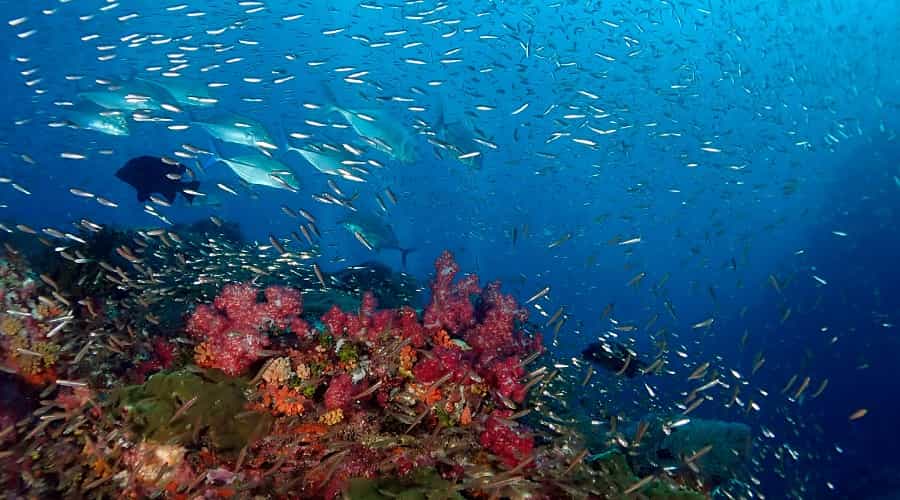
Considered one of the best dive sites in the world, this National Marine Park consists of 9 islands for divers to explore, each with rich biodiversity, tropical sea life and underwater topography. Visibility is excellent at 20m-30m and the currents are generally mild. The most famous dive site is Elephant Head Rock where divers are treated to an underwater playground of tunnels, caves and swim-troughs. The other recommended site is Christmas Point which contains large boulders, drop offs and macro species. Both sites are recommended for experienced divers as the current can be stronger here and the locations are deep.
- Diving skill: Intermediate – advanced
- Water temperature: 26C – 28C
- Best time to dive: November – April
- Marine life: Black/white tip reef shark, leopard shark, whale shark trigger fish, barracuda, mantas, coral gardens and feather stars.
Surin Islands
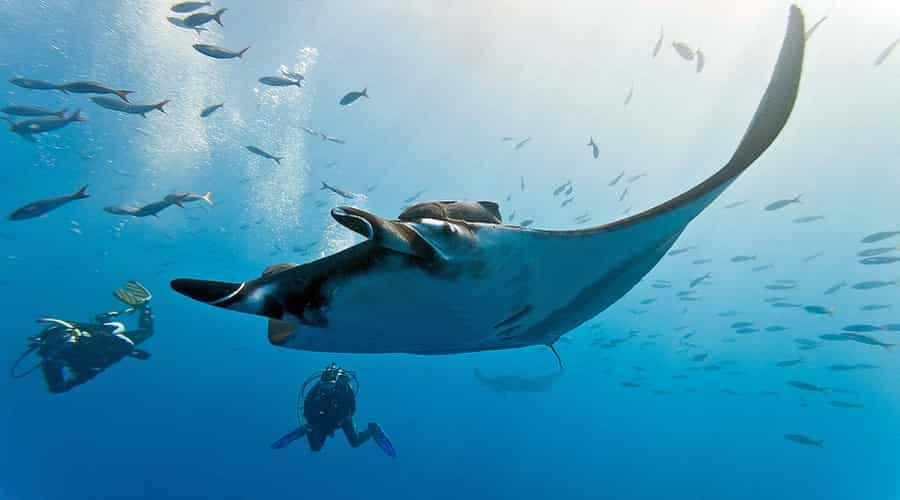
Featuring the greatest variety of hard coral reefs in Thailand, the Surin Islands are a quieter dive region, containing many different species of fish and larger marine creatures.
Richelieu Rock is a prime spot for sighting whale sharks and is often considered the best place to dive in Thailand. February, March and April are your best chances of spotting these elusive sharks.
Koh Tachai is often visited on the way to Richelieu Rock and is a site for experienced divers as it often has strong currents. With plenty of boulders, sheet corals and cut-troughs, divers will be rewarded with large sea creatures including manta rays and leopard sharks.
- Diving skill: All levels, Koh Tachai – Advanced
- Water temperature: 26C – 29C
- Best time to dive: December – April
- Marine life: Mantas, turtles, eagle rays, whale sharks, trevallies, napoleon wrasse, ghost pipefish, humpnose bigeye bream, snappers, nudibranch and hard coral reefs.
Khao Lak
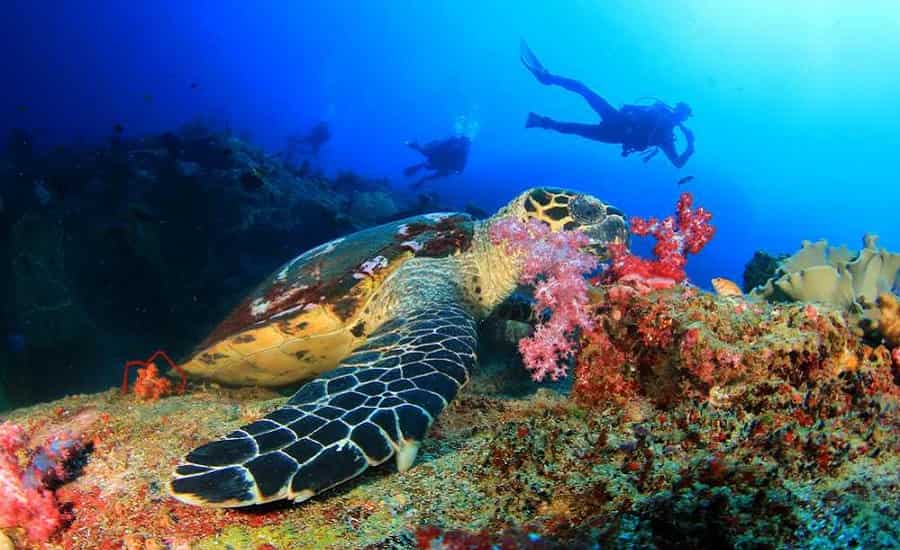
Over recent years, Khao Lak has proved itself to be a favoured destination among intermediate divers. Prepare to see everything from large pelagics to colourful macro critters. Currents are moderate and water clarity can reach 30m. A couple of recommended wrecks to visit include the Bunsoong and Sea Chart I. The latter is a deep technical dive for experienced divers.
- Diving skill: Intermediate
- Water temperature: 26C – 30C
- Best time to dive: November – April
- Marine life: Sea snakes, reef sharks, nurse sharks, leopard rays, trevally, tuna, frogfish, ribbon eels, seahorses and yellowtail barracuda.
Central Region
Koh Phi Phi
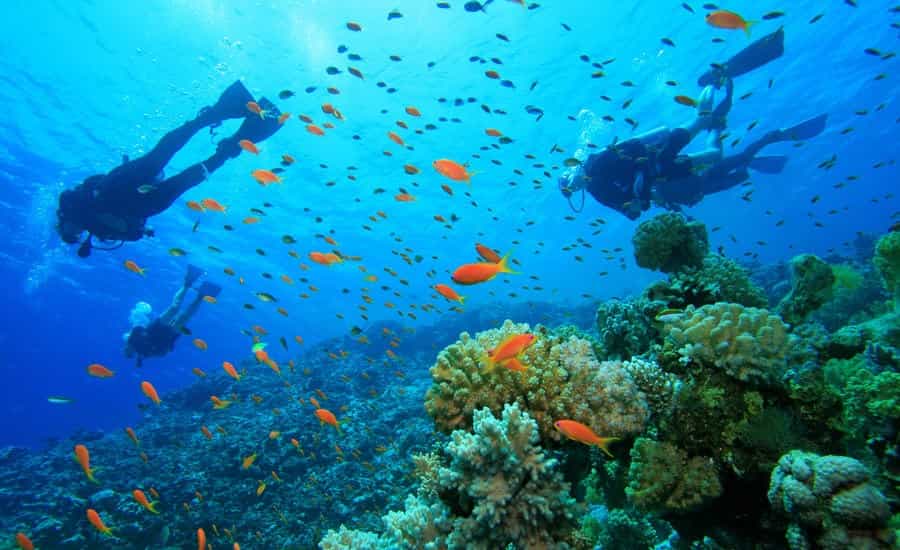
Nestled within Phi Phi island lies more than 15 dive sites for all skill levels. Underwater, divers can marvel at the bright soft coral walls, gorgonian fans, hollowed caverns and myriad of marine life. Currents are often mild and visibility ranges from 5m-30m.
Bida Nok and Bida Nai are considered two of the best dive sites in Phi Phi. Both have rich ecosystems teeming with diverse sea creatures, including hawksbill turtles and sea snakes.
- Diving skill: Beginner/Intermediate
- Water temperature: 27C – 30C
- Best time to dive: February – May
- Marine life: Leopard sharks, angelfish, frogfish, crocodile long-toms, scorpionfish, shrimp, pipefish, soft coral gardens, sea whips and stag horn.
Phuket
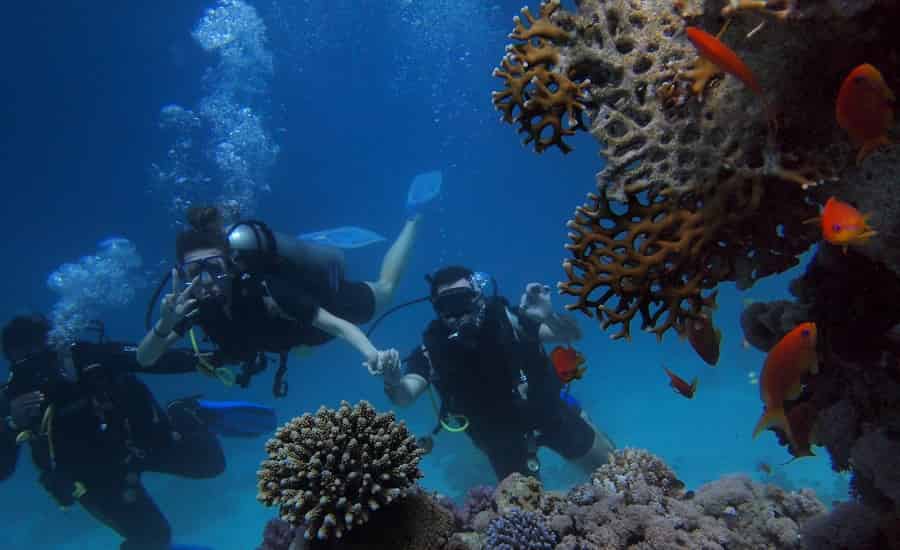
Boasting more than 30 dive sites, scuba divers return to Phuket year after year to experience the underwater attractions located around the island. King Cruiser Wreck is a very popular site for experienced divers and shows a car ferry that sank in 1977. Shark Point is the best place to spot tame leopard sharks basking on the ocean floor and is suitable for beginners. Anemone Reef is another beginner’s site that is known for the vast limestone pinnacle protruding 30m up from the seabed and covered in multi-coloured anemones. Racha Noi has intriguing topography with transparent waters and is the best site for spotting manta rays, dolphins and whale sharks. With strong currents and deep waters, divers here should be at an advanced level.
- Diving skill: All levels
- Water temperature: 27C – 30C
- Best time to dive: November – April
- Marine life: Whale sharks, grey reef sharks, cuttlefish, turtles, leopard sharks, clownfish, fusiliers, squid, pipefish, tuna, schooling jacks, hard and soft corals.
Krabi
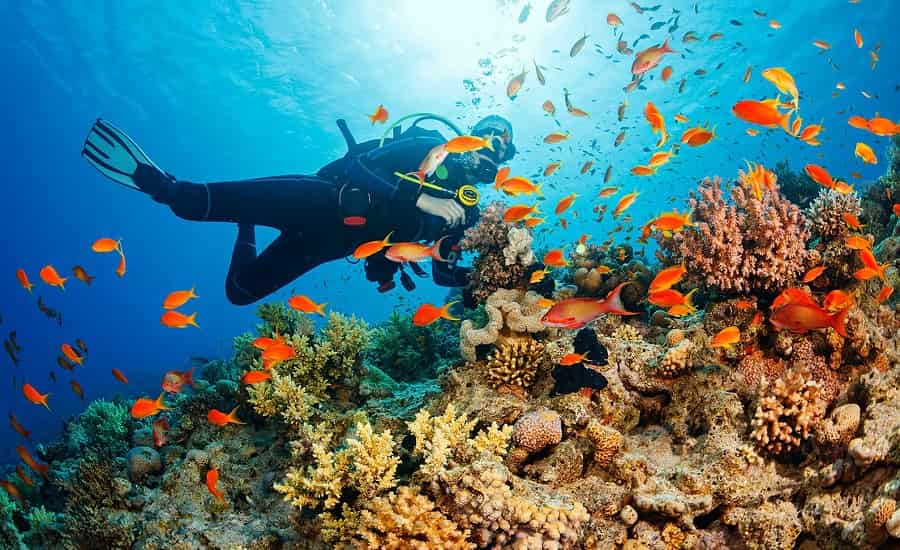
With more than 200 species of fish and 80 types of coral recorded, there is much to see and appreciate under the turquoise waters of Krabi. Departing from Ao Nang beach, Krabi’s small islands offer divers everything from swim- troughs to gentle slopes and wide caverns. With mild currents, calm surface waters and shallow parts, Krabi is an ideal location for beginners.
- Diving skill: Beginner
- Water temperature: 27C – 31C
- Best time to dive: November – April
- Marine life: Ghost pipefish, barracudas, leopard sharks, hawksbill turtles, passing manta rays, sea snakes and black tip reef sharks.
Southern Region
Hin Daeng
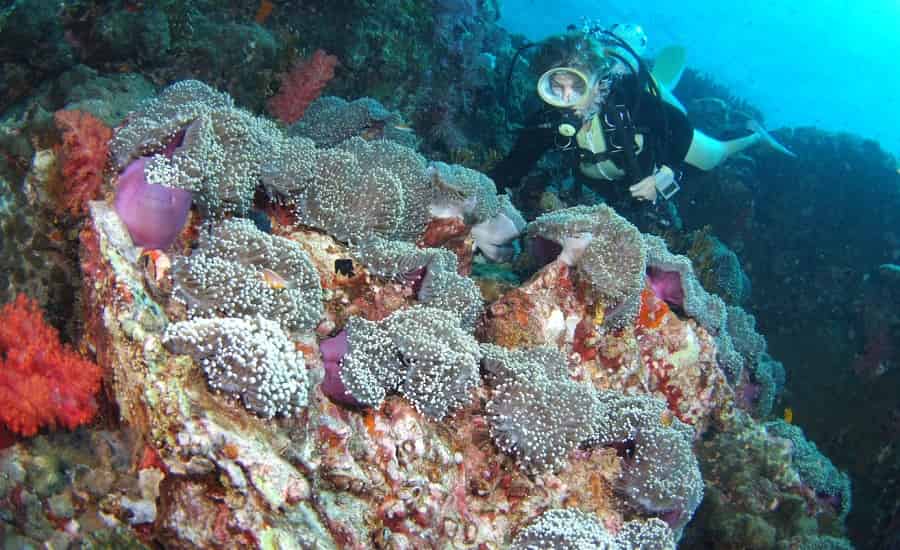
Thai for ‘Red Rock,’ Hin Daeng is a deep dive site that is best known for sighting giant manta rays. The rare whale sharks have also been spotted here on occasion. This underwater rock formation is covered in soft red coral and reaches depths of more than 40m, making it a site for experienced divers.
- Diving skill: Intermediate – advanced
- Water temperature: 27C – 30C
- Best time to dive: November – April
- Marine life: Grey reef sharks, leopard sharks, crayfish, barracuda, octopus, fusiliers, cowries, crocodile long toms, shrimp, crabs and moray eels.
Hin Muang
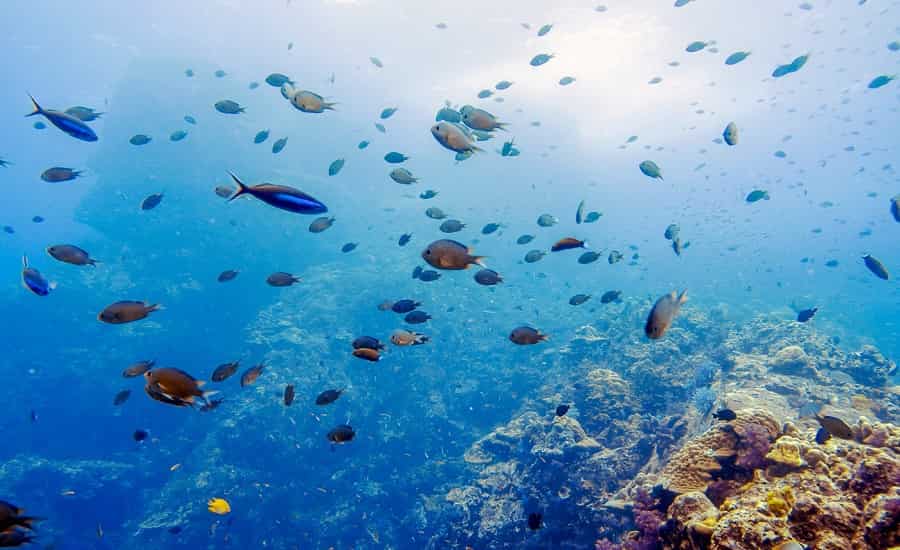
Located 500m from Hin Daeng, Hin Muang or ‘Purple Rock’ is a fully submerged rock pinnacle coated in soft purple corals. With a steep vertical wall and depths reaching more than 40m, divers should be on the lookout for groups of pelagics interspersed with a variety of macro life. With a potentially strong current and rough surface condition, this dive is recommended for experienced divers only.
- Diving skill: Advanced
- Water temperature: 27C – 30C
- Best time to dive: November – April
- Marine life: Leopard sharks, grey reef sharks, manta rays, barracuda, fusiliers, yellow snapper, tuna and bryozoan.
Koh Tarutao
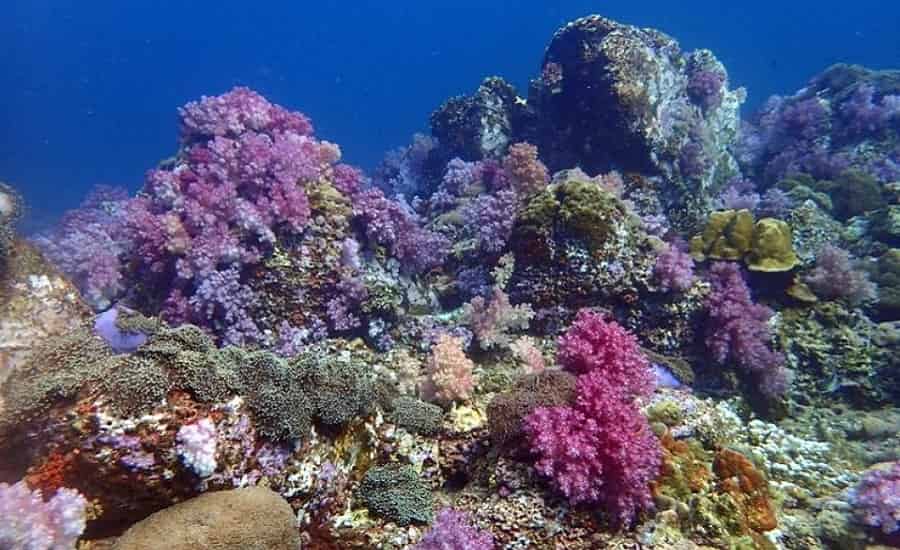
Part of Thailand’s oldest National Park, Koh Tarutao consists of a number of small islands and is a relatively unknown spot among tourists. Under the clear blue waters, divers will find vibrant coral reefs and numerous species of tropical fish. Top dive sites include Koh Lipe where you can scout blue-spotted stingrays among challenging formations and Eight Miles Rock which drops to more than 50m and is an exhilarating dive due to the strong currents.
- Diving skill: Intermediate – advanced
- Water temperature: 27C – 30C
- Best time to dive: February – April
- Marine life: Dolphins, dugong, minke and sperm whales, lionfish, angelfish, trumpetfish, butterflyfish, groupers, trevally and devil rays.
Gulf of Thailand
Koh Tao
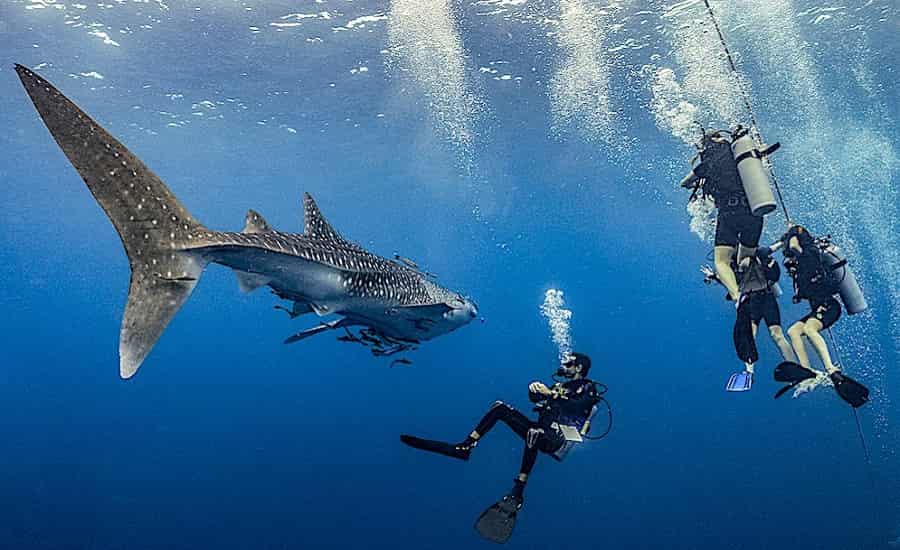
Although a popular location for learner divers, Ko Tao has dive sites and attractions that appeal to all levels. Rich with hard corals, anemones and sloping reefs, the sea bed is also home to various species of fish and macro marine life. Chumphon Pinnacle is one of the well-known dive sites, with a central pinnacle bordered by smaller rocky outcrops attracting anemonefish and the infamous whale shark. Another great site is Southwest pinnacle which features large boulders covered in green, pink and gold anemones.
- Diving skill: Beginner – intermediate
- Water temperature: 28C – 29C
- Best time to dive: May – September
- Marine life: Whale sharks, reef sharks, leopard sharks, spotted eagle rays, barracuda, titan triggerfish, turtles, gobies, parrotfish, damsels, batfish and snappers.
Koh Samui
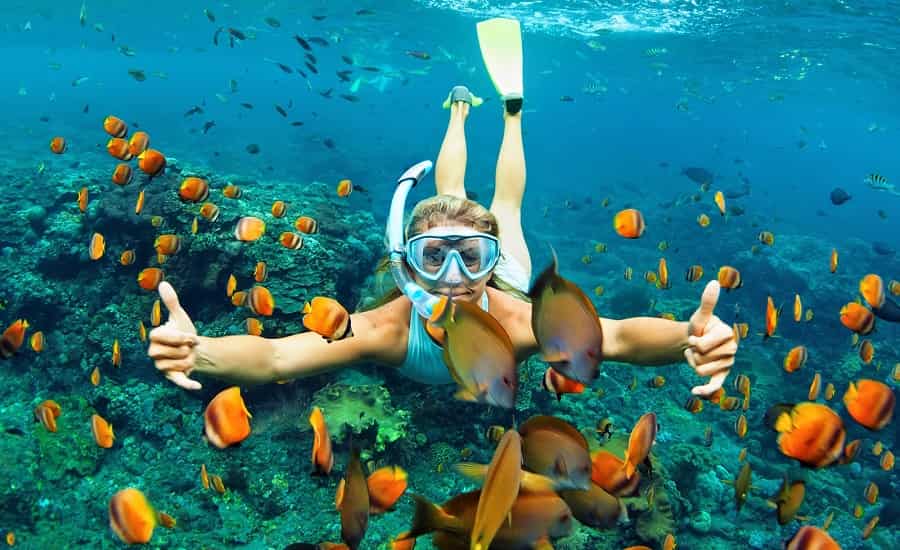
The most popular tourist destination on Thailand’s East Coast, Koh Samui has around 10 diving spots covering a range of skill levels. One highly recommended site is Sail Rock which features a large granite rock protruding from the surface of the sea. With no other rocks in the vicinity, fish and critters flock to the area, not to mention the occasional whale shark.
- Diving skill: All levels
- Water temperature: 27C – 29C
- Best time to dive: March – September
- Marine life: Whale sharks, turtles, snapper, stingrays, triggerfish, barracuda, fusiliers, lionfish, cuttlefish, longfin batfish and blue-ringed angelfish.
Pattaya
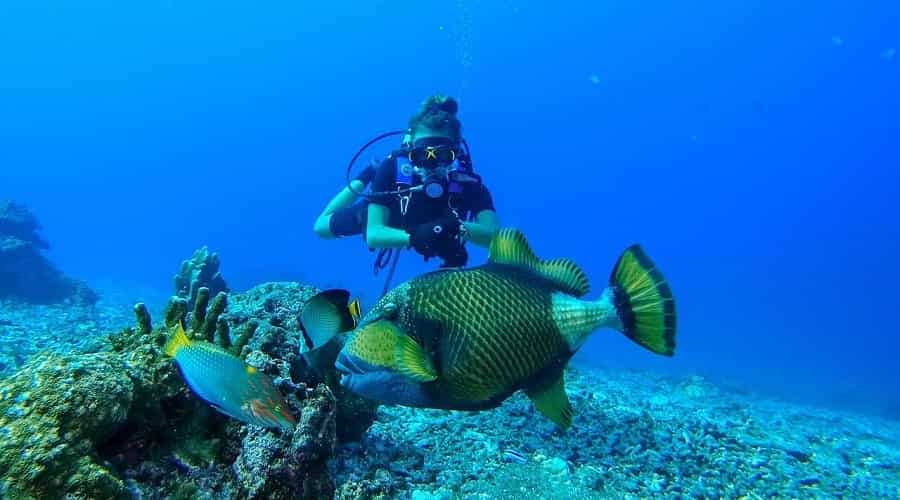
Just a short drive from Bangkok, Pattaya has 12 islands and more than 30 dive sites. It is best known for its great shipwrecks: HTMS Khram and HTMS Khut are artificial reefs that were purpose-sunk in 2003 and 2006 and are now overrun with tropical fish and sea critters. Hardeep Wreck has been underwater for over 60 years and is a thriving artificial reef coated in coral and inundated with multi-coloured reef fish. Suitable for all levels, it is also a popular location to learn scuba diving.
- Diving skill: All levels
- Water temperature: 27C – 29C
- Best time to dive: November – March
- Marine life: Turtles, stingrays, bamboo sharks, nurse sharks, butterflyfish, fusiliers, angelfish, pufferfish, batfish, barracuda, morays and cuttlefish.
Thailand Diving courses and costs
PADI dive courses are available in Thailand and can be completed with various dive companies. Upon completion, you will receive a PADI scuba diving license which will allow you to access numerous dive sites around the world. Covering all skills levels, the following courses are available:
– PADI Discover Scuba Diving
For those wishing to sample scuba diving, this 1 day programme will give you a basic overview of diving skills and an instructor will assist you in completing 2 open water dives. Depending on location, costs range from 102 USD to 150 USD.
– PADI Scuba Diver course
If you are a traveller with limited time but still want to gain diving experience, this pre-entry level certification is great, especially if you only plan on diving a few times a year. Over 2 days, you will complete class and pool dive training, followed by 2 boat dives with a fully qualified instructor. Depending on location, prices range between 264 USD and 435 USD.
– PADI Open Water Diver course
If you have completed the ‘Scuba Diver’ course, the knowledge gained will give you a head start on this course. However, previous diving experience is not required and the open water course is a great introduction to scuba diving. Lasting for 3 days, students will undertake class and pool training before completing 4 boat dives in one of Thailand’s prime dive sites. Prices vary from 414 USD to 447 USD depending on location.
– PADI Advanced Open Water Diver course
A step up from open water, the advanced course will enhance your diving skills and award you with unforgettable experiences. Over 2 days, you will complete a number of particular dives, designed to increase your performance and learn something new. You will be in the open water for the entire course, executing 5 dives including adventure dives if you choose. Depending on location, prices range from 339 USD to 390 USD.
Note: the above courses can be completed in Phuket, Phi Phi Island and Krabi and the prices vary depending on the location.
– PADI Dive Master course
For experienced scuba divers, this course is one away from instructor level and requires advanced scuba skills and a strong understanding of diving theory. Upon completion, you will receive specific diving qualifications. Over a period of 14 days, students will complete 3 modules and have a minimum of 60 dives logged in order to receive dive master status. Prices start at 900 USD.
Thailand Diving Packages – what are my options?
A number of companies in Thailand offer scuba diving daytrips and diving packages for adventurous scuba divers. Liveaboards are highly popular in Thailand and are simply self-sufficient boats that take you to dive sites during the day and double up as accommodation on an evening. Packages vary in duration, cost and provider. Examples of popular trips include:
- 3 day liveaboard in Phi Phi Island which includes 11 dives, all meals and accommodation for around 720 USD.
- 4 day liveaboard in the Similan Islands which includes 14 dives, all meals and accommodation for around 910 USD.
- 7 day liveaboard exploring the Andaman Sea which includes 25 dives, all meals and accommodation for around 1,478 USD.
One can also buy shore based diving packages where the diving operator takes you on 2 to 3 dives daily to some of the best spots in a certain region. Prices vary depending on the dive sites being covered and the distance from the shore. You are also likely to get a discount when booking in bulk.
Do I need diving insurance?
For those planning on diving in Thailand, it is highly recommended that you invest in travel insurance that covers scuba diving before you arrive. Alternatively, there are options to just take out diving insurance. There are a number of providers to choose from and it is important that you find the one appropriate for your travel and diving needs. Some options available include:
– Dive Assure – Here you can select diving insurance and include travel insurance as an add-on. The options are short-term and annual coverage. Short-time diving coverage for 1 week starts from around 55 USD and covers medical expenses, loss of personal diving equipment, flight/accommodation costs following a diving accident and more. Annual coverage is around 99 USD for Gold and 129 USD for Platinum. Prices vary depending on country of residence, date of birth, date of travel, type of coverage and travel insurance add-on.
– World Nomads – This provider combines your diving insurance with your travel insurance and covers oversees medical expenses, medical evacuation, trip cancellation and more. The overall price takes into account your travel destination, age, country of residence and duration of trip. They offer a standard and an explorer policy, depending on your requirements. Prices vary, but 1 week for standard insurance is around 78 USD.
Thailand Weather – what is it like?
With a tropical climate, the weather in Thailand is often hot and humid with heavy bursts of rainfall during wet seasons. The average temperature ranges between 30C and 36C all year round, the hottest months being April and May. Water temperatures average between 27C and 31C throughout the seasons. Covering a fairly large area, Thailand weather can be split into 2 regions:
Northern Thailand – Dry season runs between November and May and monsoon season is from June to October, where rainfall ranges from light showers to heavy flooding.
Southern Thailand – Receiving the majority of rainfall in Thailand, the southern region has a distinct wet season. On the west coast, this is between April and October. Alternatively, the east coast has heavy monsoons from September through to December. In between the rainfall, the weather in the South is hot and dry.
When is the best time for diving in Thailand?
Scuba Diving in Thailand is accessible all year round. The best months to dive the Andaman Sea are from November to April when the waters are calm, visibility is excellent and the weather conditions are optimal. For the best chance to sight whale sharks and manta rays, diving is recommended between February and May.
The remaining months are likely to encounter more rain particularly on the west coast, leading to poorer visibility and fewer liveaboard trips.
The dive season for the Gulf of Thailand however is between March and September, making it a good alternative to the Andaman Sea during these months.
Flights to Thailand – what are my options?
The major international airport in Thailand is Suvarnabhumi Airport in Bangkok. It also has the best connectivity for flights to Thailand. There are a number of smaller airports often used for domestic flights however some also have international arrivals. They include Phuket, Chiang Mai, Hat Yai and Koh Samui.
Depending on your departure airport, most flights from the US and Europe will require a stopover. Some major cities in Europe offer direct flights however the price is generally steeper. Cheapest flights tend to be those departing from Australia or other countries in Asia.
If you are travelling from the US or Europe, consider flying into one of the major stopover airports like Seoul or Hong Kong and then using a budget airline to fly to Thailand. If you are flying into one of the smaller airports, it is likely that you will have to fly from Bangkok, so take this into consideration when you are planning your Thailand flights.
Be aware that flight prices are likely to increase during peak season. Consider travelling in the quieter months during the dry season.
Thailand Hotels & Resorts – some good options
Depending on your location preferences, hotels in Thailand have extensive options in the city, near the beach front and on many of the islands to suit all budgets. Here is a rundown of some great places to stay in Thailand, covering all levels of pricing:
Hacienda Beach Resort, Koh Samui
Experience a relaxing and peaceful stay in one of Hacienda’s idyllic bungalows surrounded by lush green gardens and right next to the white sandy beach.
- Location: Koh Samui
- Travel type: Budget
- Average cost per night: 43 USD
- Star rating: **
Chanalai Flora Resort, Phuket
With scenic views of Kata Beach, this family-friendly resort offers a luxury stay at an affordable price. Priding themselves on quality service, guests will be well looked after by the caring and helpful staff.
- Location: Kata Beach, Phuket
- Travel type: Budget
- Average cost per night: 45 USD
- Star rating: ***
L’Alcove, Koh Phangan
Just a 1 minute walk from the beautiful beach of Hinkong Bay, these spacious bungalows offer guests simple yet cosy accommodation with a French beachfront bistro.
- Location: Koh Phangan
- Travel type: Budget
- Average cost per night: 60 USD
- Star rating: **
Koh Tao Resort, Koh Tao
Located on a hilltop overlooking the beautiful bay, this resort is also named the ‘Paradise Zone’ and for good reason. With stylish accommodation to suit all budgets and breath-taking sunset views, this hotel is a number one choice among travellers.
- Location: Koh Tao
- Travel type: Budget
- Average cost per night: 65 USD
- Star rating: ***
Centre Point Silom, Bangkok
Right in the heart of the city, this stylish yet affordable hotel is nearby to numerous Bangkok attractions, as well as the lively nightlife and shopping facilities.
- Location: Bangkok
- Travel type: Value for money
- Average cost per night: 95 USD
- Star rating: ****
Khum Phaya Resort & Spa, Chiang Mai
This Lanna style boutique hotel offers guests a high-quality, comfortable stay at good value for money. Just a 10 minute walk from Chiang Mai old town, the hotel is also close to local attractions, including the zoo and aquarium.
- Location: Chiang Mai
- Travel type: Value for money
- Average cost per night: 100 USD
- Star rating: ****
Phi Phi Andaman Beach Resort, Phi Phi Don
Situated on the stunning beachside of Ton Sai Bay, this resort offers guests a flavour of paradise at an affordable cost. With comfortable rooms and a private balcony, the hotel is also close to many popular landmarks.
- Location: Phi Phi Don
- Travel type: Value for money
- Average cost per night: 85 USD
- Star rating: ***
Bo Phut Resort & Spa, Koh Samui
Nestled in the north of Koh Samui, this upmarket hotel has a beachfront location, bounded by tropical vegetation. Kitted out with modern facilities in a Thai style setting, guests will experience a tranquil and relaxing retreat.
- Location: Koh Samui
- Travel type: Affordable Luxury
- Average cost per night: 200 USD
- Star rating: ****
Layana Resort & Spa, Krabi
A truly relaxing experience, Layana Resort is an adults-only hotel that prides itself on helping guests achieve peace and rejuvenation. With plenty of local excursions and activities available, this hotel caters to guest’s every need.
- Location: Koh Lanta, Krabi
- Travel type: Affordable luxury
- Average cost per night: 205 USD
- Star rating: *****
137 Pillars House, Chiang Mai
An elegant and tranquil setting, this boutique hotel offers guests luxury and wellness throughout their stay. Surrounded by tropical gardens and modern amenities, guests can expect exquisite dining, spacious rooms and optimal comfort.
- Location: Chiang Mai
- Travel type: Luxury
- Average cost per night: 425 USD
- Star rating: *****
The Siam, Bangkok
Combining intricate architecture with modern facilities, The Siam is an urban sanctuary situated among acres of green gardens with signature fine dining. Offering ample on-site facilities and close to Bangkok’s cultural attractions, this luxury accommodation will leave guests feeling fully rejuvenated.
- Location: Bangkok
- Travel type: Luxury
- Average cost per night: 580 USD
- Star rating: *****
Things to do in Thailand
Thailand has much more to offer that just great scuba diving. Here are some other amazing activities and things to do in Thailand:
The Grand Palace
If you are visiting Bangkok, this iconic landmark is a must see for any tourist. Displaying awe-inspiring architecture and hand-crafted detail, this complex is home to some beautifully photogenic attractions.
Floating markets
There are a number of traditional floating markets around Bangkok, offering authentic Thai food, tropical fruits and delicious drinks. The most popular (located 100km from Bangkok) is Damnoen Saduak, however there are other markets closer to the CBD with less tourists.
Phi Phi Island
Just a short boat ride away, you will find 6 beautifully preserved islands perfect for day trips or overnight stays. With white sandy beaches, bright blue waters and incredible rock formations, tourists are sure to experience a taste of paradise.
Khao Yai National Park
Covering more than 2,000 square kilometres, Khao Yai contains native species, mountainous terrain, lush rainforest and stunning waterfalls.
White water rafting
For adventure junkies, head to Chiang Mai and experience grade 3 and 4 rapids on the fast-moving river as it meanders through the scenic forest.
Boat trips
Surrounded by islands that vary in size and popularity, Thailand is the perfect place to explore the picturesque scenery away from the bustling CBD. One recommended trip is Ang Thong to Koh Tao and Koh Nang Yuan where visitors can explore the nearby areas by kayak.
Rock climbing
Moving on from water-based activities, the limestone cliffs in Krabi are a rock-climber’s dream. With over 650 routes, there is something for everyone, from novices to experts.
Beach day
Take a relaxing break from all the activities Thailand has to offer and treat yourself to one of its many beautiful beaches. Phang Nga Bay is famous for starring in a James Bond movie and is a popular landmark among tourists. Other favourites include Railay Beach in Krabi, Donald Duck Bay in Similan Islands, Kata Beach in Phuket and White Sand Beach in Koh Chang.
Thailand Visa – do I need one?
Depending on your country of origin, eligible visitors will either be allowed to enter Thailand without a visa or may apply for a Visa on arrival. The period of stay varies depending on your nationality, the majority being 30 days. Check out the list of countries here.
For those wishing to stay longer, you can apply for a Thai tourist visa and stay up to 60 days, or a non-immigrant visa which allows up to 90 days. You can also access a work permit on the non-immigrant visa.
Other visas are available and you can find out more by visiting the Thai Embassy website.
Thailand Vaccinations – which ones do I need one?
All travellers should take the necessary precautions when travelling to South East Asia to protect themselves against preventable diseases. It is recommended to obtain the following vaccinations 4-6 weeks before travelling to Thailand:
- Hepatitis A and Typhoid
- Hepatitis B
- Tetanus/Diphtheria
- Japanese Encephalitis (for travellers intending to stay a while in Thailand/for those taking part in frequent outdoor activities/for those travelling to remote areas)
Mosquito-borne diseases such as Malaria, Dengue Fever and the Zika Virus are present in certain areas of Thailand, however risk is low in areas such as Bangkok, Koh Samui, Phuket and Chang Mai. However, precaution should always be taken against mosquito bites, including wearing long clothing and using repellent that contains DEET.
Always consult with your doctor about vaccinations before travelling.
Thailand Packing List – what to take?
With a hot climate all year round, opt for lightweight clothing such as cotton T-shirts, dresses and pants, plus swimwear. Consider packing conservative outfits if you intend on visiting temples as this shows respect. Also include a light rain jacket regardless of the time of year as there is always the possibility of rain with a tropical climate. If you are travelling around Thailand, a warm jacket is a useful item for the buses/flights that are often heavily air-conditioned.
Primary footwear is slip-on sandals or flip-flops as many places require you to remove your shoes before entering (temples and some restaurants and shops for example). If you are contemplating hiking, also pack a pair of light walking shoes.
Many non-essential items can be purchased in Thailand at a highly reduced rate, so it is smart to only pack what you need and carry less weight.
For diving in Thailand, you need not bring wetsuits as you can always rent cheaply.
For Females:
- 3-4 shorts
- 3-4 shirts
- 1 or 2 nice dresses for bars and discos
- A beach dress/cover up
- 1 or 2 pairs of Yoga pants
- 1 light sweater
- 5 to 6 underwear
- 2 to 3 bras
- 2 bathing suits
- 2 sleeping suits
- 2 sandals
- 1 flipflops
For Males:
- 3 shorts
- 2 gym shorts/bathing suits
- 4 t-shirts
- 2 collared shirts for bars or discos
- A pair of jeans
- A light jacket
- 5 underwear
- 3-4 socks
- 1 flip flops
- 1 tennis shoes or walking shoes
- 1 shoes that can be worn in a nice bar or disco
Toileteries:
- Travel size shampoo, conditioner, body soap or gel
- Deo
- Toothbrush/paste and floss
- Razors
- Makeup
- Hairbrush/straightener if the hotel does not provide one
- 1 Beach towel – you may possibly get one from hotel too
- Sunscreen – this can be expensive in Thailand, so it is best to get one from home
- Mosquito repellent with high DEET
Thailand Nightlife – a quick introduction
The vibrant nightlife of Thailand is particularly dominant in areas of Bangkok and Phuket. Whether you are a tourist or a local, Thailand offers something for all tastes from upmarket rooftop bars to lively late-night clubs and trendy beach bars. Here are some of the top nightlife spots to visit when in Thailand:
Soi Bangla (Central Patong, Phuket)
Bangla Road is the party hub of Phuket and a top tourist attraction. Cluttered with beer bars, nightclubs and entertainment complexes, this street comes alive at night. To really experience a Thai night out, popular venues include Soi Tiger, Soi Seadragon, Soi Gonzo and Soi Freedom.
Beach Clubs (Phuket)
As well as a lively night scene, Phuket is also a prime location for laid-back, sophisticated beach clubs. With the majority situated on the sea front, you can watch the sun set with a hand-crafted cocktail, listen to live DJ’s and dine on delicious tapas. Recommended spots include Café del Mar, Catch Beach Club, Kudo Beach Club and HQ Beach Lounge.
Rooftop Bars (Bangkok)
The capital city is well-known for its stunning 360 degree views from the number of chic rooftop bars. Overlooking the bustling streets below, guests can indulge in fine wine and colourful cocktails, whilst taking in the beautiful lights of the city at night. Highly recommended bars include Vertigo, Sky Bar, Octave, Park Society and Above 11.
Night Markets (Bangkok)
Bangkok nightlife has much more to offer than just bars and nightclubs. Across the city, night markets are set up with an assortment of goods, produce, fashion and entertainment. Shop for local items at bargain prices. Some of the best markets in Bangkok include Rot Fai Market, JJ Green, Asiatique and Patpong.
Bars (Chaweng, Koh Samui)
On an evening, Chaweng turns into a prime spot for partygoers. Featuring everything from late-night dance clubs to chilled-out bars to transvestite floorshows, there is something for all tastes in this bustling town. Try the street bars along Soi Green Mango or beachside venue Ark Bar which entices travellers from all around the world with live displays and chilled vibes. Other cool bars to check out include Legends Bar, On Street Bar and Bar Solo.
Bars (Koh Phi Phi)
On Phi Phi Don Island, nightlife ranges from big party scenes with unlimited cocktail buckets to relaxed beachside venues with casual beers and chilled-out tunes. Phi Phi Reggae Bar adds an unusual attraction into the mix of regular bar activity – a giant boxing ring in the centre of the venue. Professional displays of Muay Thai (Thai boxing) are held nightly and bring a huge crowd of spectators. More chilled out scenes include Sun Flower Beach Bar & Restaurant, Banana Rooftop Bar and Hippies Bar. For a wilder night, visit Slinky Bar, Ibiza Beach Club and Apache Beach Bar.
Full moon party (Koh Phangan)
Once a month, partygoers flock to Haad Rin Beach in Koh Phangan for the infamous full moon party, top of many Thailand bucket lists. Transforming the beach into a gigantic open-air rave, travellers come together and party till dawn under the dazzling full moon. Pulling in crowds of up to 30,000, this is an experience not to be missed.
With a very popular night scene, travellers to Thailand should be extremely cautious and drink-aware. The common alcohol option is the ‘bucket drink’ which mixes a high volume of spirits in a huge bucket. Travellers are generally unaware of how much alcohol content is in the bucket so it is wise to share with friends.
Parts of Thailand are also known for robbery, so keep your valuables on you at all times and never leave your bag or drink unattended.